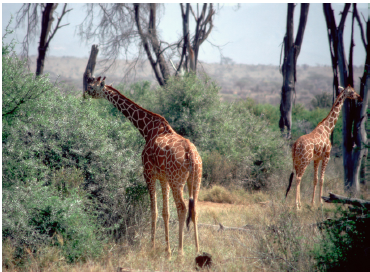Giraffe, Giraffa camelopardalis
Legal Status: Giraffes are covered by neither the U.S. Endangered Species Act nor CITES. Their IUCN Red List Status is Lower Risk (Conservation Dependent). Recent (1998) IUCN estimations suggest a total population of 141,000 (excluding populations in Sudan), including >50,000 in and around protected areas and >8,000 on private land. Total numbers are stable, with decreases in the northern and western part of their ranges matching population increases in the south.
Description: Giraffes are long-necked browsing animals that taxonomists place in a separate family, Giraffidae, from other artiodactylids: camels, deer and bovines. Possessing only seven cervical vertebrae (like other mammals), giraffes, at almost 19 feet, are the tallest of all mammals. Adult males weigh as much as 4,000 lbs.
They are characterized by having two knobs, called ossicones, on their head. Some individuals may have additional bumps on the sides of their skulls that are irregularly located. Unlike antlers on deer or horns on bovids, ossicones are permanently covered by hair and never shed. After a gestation of 15 months, females give birth to a single young; twins occur rarely. Adults are not territorial but rather feed over a large "roaming" area. When alarmed, giraffes can Giraffe taxonomy is confusing and disagreements still persist on how many subspecies should be recognized.
Some races are quite distinct and have significant zoogeographic boundaries separating them from other races. Others have no apparent barriers and hybrid/intergrade specimens may be found. Regardless, giraffes in northern and western Kenya, Uganda north and west to Niger and Nigeria all have markings contained by straight borders, and have few or no markings below their knees. Those from central Kenya south are marked all the way to the hooves, their markings, regardless of color, having jagged, irregular borders. If nine subspecies are accepted, most based on trunk spots and association with a particular geographic region.
The following subspecies are generally accepted :
Nubian giraffe, G. c. camelopardalis – eastern Sudan and Eritrea, West African giraffe, G. c. peralta – northern Nigeria, Kordofan giraffe, G. c. antiquorum – western Sudan, Reticulated giraffe, G. c. reticulata – northeast Kenya, southern Ethiopia and western Somalia, Rothschild’s or Baringo giraffe, Giraffe. c. rothschildi – western Kenya and eastern Uganda, Masai giraffe, G. c. tippelskirchi – southern Kenya and Tanzania, Thornicroft’s giraffe, G. c. thornicrofti – Luanga Valley, northern Zambia, Angolan giraffe, G. c. angolensis – southern Angola, northern Namibia to western Botswana, Southern giraffe, G. c. giraffa – southeastern Zimbabwe, South Africa to southern Mozambique.
Some authorities synopsize Kordofan and West African giraffes, Nubian and Rothschild’s giraffes and Angolan and southern giraffes together, respectively.
Range: Giraffes are widespread in Africa south of the Sahara Desert. Although they ranged all over Africa 10,000 years ago, they became extinct in North Africa as the climate changed and most of the area became desert. They vanished from Egypt more than 4,000 years ago and Morocco about 1,400 years ago. Although West and Central African populations are now small, scattered and continuing to decline, in East and southern Africa they are widespread and found in most countries having suitable mixed bush and savannah habitat.
Habitat: Giraffes roam over large areas of bush and savannah areas, living often in semi-desert regions where they get most of their water from their food.
Diet: Giraffes are browsing ungulates, feeding almost exclusively on the new shoots of shrubs and trees. Acacia trees are by far their favorite food source, the leaves being stripped from their thorny branches with the assistance of the giraffe’s long tongues and prehensile lips.
Social Organization: Giraffes are sociable, tolerant animals living in small groups to large herds or coalitions of familiar cows and calves which number from 12 to 15 animals. Although gregarious, group structure is constantly changing to some degree due to individuals’ overlapping home ranges. Including a surrounding "buffer zone", female home ranges may be as large as 46 sq. miles. Home ranges of adult bulls are smaller. There is no apparent dominance among females but adult males display absolute hierarchy within their home ranges.
Threats to Survival: Giraffes have few enemies as adults but young suffer high mortalities, up to 73% in some populations during their first year. Lions are their principle natural enemy although leopards and hyaenas take occasional animals. Today, uncontrolled poaching is their most serious threat and has been responsible for most of their range contraction in North and West Africa.
Reticulated Giraffe taken at Sambura National Park, Kenya
Conservation: Their status is not likely to change as long as good populations continue to be effectively protected in a substantial number of parks and reserves and on private land. If present trends continue, the western and Nubian/Rothschild’s giraffes, and possibly also the reticulated subspecies, will eventually be reduced to only a few small protected populations while the Masai and southern giraffes will continue to increase.














0 comments:
Speak up your mind
Tell us what you're thinking... !